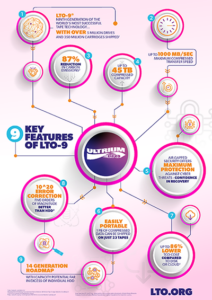 Data backup is a critical aspect of data management, and choosing the right storage medium is crucial. Tape and hard disks are two common options, and in recent years, tape storage has gained renewed attention due to its cost-effectiveness, reliability, and security advantages. This article explores the usefulness of tape for backup in comparison to hard disks, considering factors such as cost, capacity, durability, longevity, energy efficiency, cybersecurity, and the concept of an air gap.
Data backup is a critical aspect of data management, and choosing the right storage medium is crucial. Tape and hard disks are two common options, and in recent years, tape storage has gained renewed attention due to its cost-effectiveness, reliability, and security advantages. This article explores the usefulness of tape for backup in comparison to hard disks, considering factors such as cost, capacity, durability, longevity, energy efficiency, cybersecurity, and the concept of an air gap.
Consider the LTO-9 standard features a whopping 18TB native and 45TB compressed capacity, per tape! Natively at 400MB/second, you can fill an 18TB tape, impressively, in under 2 hours (about 5 hours for 45TB/compressed!). Take it off-site and you have the ultimate airgap.
Cost: What is your budget for backup solutions?
Tape storage stands out as a cost-effective option for backup solutions. Tape cartridges offer a significantly lower cost per gigabyte compared to hard disks, making it an attractive choice for organizations with large data volumes that require long-term archiving or regulatory compliance. The lower cost of tape drives and media can provide substantial savings, especially for businesses with extensive backup needs.
Capacity: How much data do you need to backup?
Tape storage has traditionally provided higher capacity than hard disks. Modern tape formats, such as LTO (Linear Tape-Open), offer impressive capacities ranging from tens of terabytes to multiple petabytes per cartridge. This high capacity makes tape an ideal choice for organizations with vast amounts of data, reducing the need for numerous hard disks or expensive cloud storage options.
Durability: How important is data integrity and longevity for your backups?
Tape media is known for its durability and data integrity. Unlike hard disks, which can be prone to mechanical failures or data corruption, tapes have a lower risk of physical damage. They are not affected by power outages or surges and are resistant to magnetic fields and temperature fluctuations. By employing tape backups, organizations can ensure the preservation of data over extended periods, minimizing the risk of data loss.
Longevity: How long do you need to retain your backup data?
Tape storage excels in long-term data retention scenarios. Tape cartridges have an average shelf life of 30 years, significantly longer than the typical lifespan of hard disks. This longevity ensures that archived data remains accessible and reliable for extended periods, meeting regulatory requirements and mitigating the risk of data loss. For organizations that require extended data retention, tape offers a robust and dependable solution.
Energy Efficiency: Do you prioritize energy efficiency in your backup infrastructure?
Tape storage provides superior energy efficiency compared to hard disks. Unlike hard disks that continuously consume power even during idle periods, tape drives only consume energy when actively reading or writing data. This energy-efficient nature of tape reduces operational costs and contributes to a greener IT infrastructure, making it an environmentally friendly choice.
Cybersecurity and Air Gap: How important is data security and protection against cyber threats?
Tape storage, particularly when combined with the concept of an air gap, offers enhanced data security. An air gap refers to the physical isolation of backup data from the network, creating an offline copy that is disconnected from online systems. This isolation provides an extra layer of protection against cyber threats such as ransomware attacks, where online systems are compromised. By keeping backup data on tape cartridges stored offline, organizations can minimize the risk of unauthorized access or data breaches.
Tape storage offers a compelling solution for backup needs, providing cost-effectiveness, high capacity, durability, longevity, energy efficiency, and enhanced data security with the concept of an air gap. While hard disks excel in immediate data access and random retrieval, tape storage is ideal for organizations with large data volumes, long-term archiving requirements, limited budgets, and a focus on data security. By considering factors such as cost, capacity, durability, longevity, energy efficiency, cybersecurity, and the concept of an air gap, organizations can make an informed decision on whether tape or hard disks are the most useful medium for their backup strategy.
WTG offers many backup and data protection solutions and professional services expertise to help with data protection and information security strategies. Our solutions can write to both disk and tape (and cloud). Please contact us if you have any questions or need some help!


